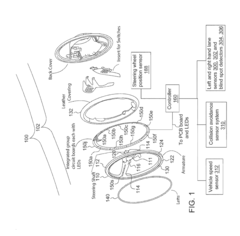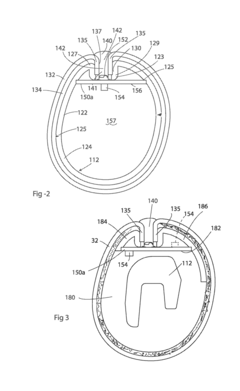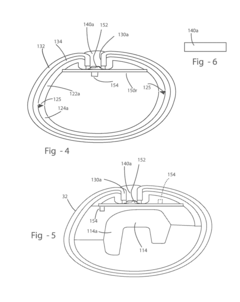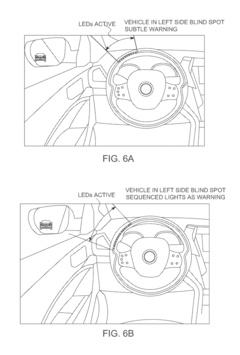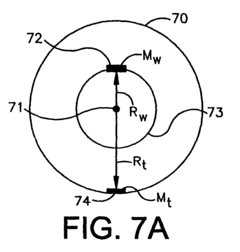Steering Wheel Technologies: Impact on Vehicle Performance
JUL 18, 20259 MIN READ
Generate Your Research Report Instantly with AI Agent
Patsnap Eureka helps you evaluate technical feasibility & market potential.
Steering Tech Evolution
The evolution of steering wheel technologies has significantly impacted vehicle performance over the years. From the early days of manual steering to today's advanced electronic systems, the progression has been marked by continuous improvements in control, safety, and driver experience.
In the early 20th century, steering systems were purely mechanical, relying on direct linkages between the steering wheel and the wheels. This era was characterized by heavy steering effort, especially at low speeds, and limited responsiveness. The introduction of power steering in the 1950s marked a significant milestone, reducing the physical effort required to steer and improving maneuverability.
The 1960s and 1970s saw the refinement of hydraulic power steering systems, which became standard in most vehicles. These systems used hydraulic pressure to assist in turning the wheels, greatly enhancing driver comfort and control. However, they were not without drawbacks, including parasitic power loss and reduced fuel efficiency.
The late 1980s and 1990s brought about the advent of electronic power steering (EPS). This technology replaced hydraulic systems with electric motors, offering more precise control and eliminating the need for hydraulic fluids. EPS systems also allowed for variable assist, providing more support at low speeds and less at high speeds for improved road feel.
The turn of the millennium saw the integration of steering systems with other vehicle technologies. Adaptive steering systems emerged, capable of adjusting the steering ratio based on vehicle speed and driving conditions. This innovation enhanced both low-speed maneuverability and high-speed stability.
In recent years, steer-by-wire technology has gained traction, completely eliminating the mechanical connection between the steering wheel and the wheels. This system uses sensors and actuators to translate driver input into wheel movement, offering unprecedented customization of steering feel and response.
The latest developments in steering technology focus on integration with advanced driver assistance systems (ADAS) and autonomous driving capabilities. Modern steering systems now incorporate features like lane-keeping assist, automated parking, and collision avoidance, blurring the lines between driver input and computer-controlled steering.
Looking ahead, the future of steering wheel technologies is likely to be shaped by the continued evolution of autonomous vehicles. We may see the development of retractable or foldable steering wheels for vehicles that can switch between manual and autonomous modes. Additionally, haptic feedback systems and augmented reality displays integrated into steering wheels are poised to revolutionize the driver interface, providing more intuitive and informative driving experiences.
In the early 20th century, steering systems were purely mechanical, relying on direct linkages between the steering wheel and the wheels. This era was characterized by heavy steering effort, especially at low speeds, and limited responsiveness. The introduction of power steering in the 1950s marked a significant milestone, reducing the physical effort required to steer and improving maneuverability.
The 1960s and 1970s saw the refinement of hydraulic power steering systems, which became standard in most vehicles. These systems used hydraulic pressure to assist in turning the wheels, greatly enhancing driver comfort and control. However, they were not without drawbacks, including parasitic power loss and reduced fuel efficiency.
The late 1980s and 1990s brought about the advent of electronic power steering (EPS). This technology replaced hydraulic systems with electric motors, offering more precise control and eliminating the need for hydraulic fluids. EPS systems also allowed for variable assist, providing more support at low speeds and less at high speeds for improved road feel.
The turn of the millennium saw the integration of steering systems with other vehicle technologies. Adaptive steering systems emerged, capable of adjusting the steering ratio based on vehicle speed and driving conditions. This innovation enhanced both low-speed maneuverability and high-speed stability.
In recent years, steer-by-wire technology has gained traction, completely eliminating the mechanical connection between the steering wheel and the wheels. This system uses sensors and actuators to translate driver input into wheel movement, offering unprecedented customization of steering feel and response.
The latest developments in steering technology focus on integration with advanced driver assistance systems (ADAS) and autonomous driving capabilities. Modern steering systems now incorporate features like lane-keeping assist, automated parking, and collision avoidance, blurring the lines between driver input and computer-controlled steering.
Looking ahead, the future of steering wheel technologies is likely to be shaped by the continued evolution of autonomous vehicles. We may see the development of retractable or foldable steering wheels for vehicles that can switch between manual and autonomous modes. Additionally, haptic feedback systems and augmented reality displays integrated into steering wheels are poised to revolutionize the driver interface, providing more intuitive and informative driving experiences.
Market Demand Analysis
The market demand for advanced steering wheel technologies has been steadily increasing in recent years, driven by the growing emphasis on vehicle safety, comfort, and performance. As vehicles become more sophisticated and automated, steering wheel technologies play a crucial role in enhancing the overall driving experience and vehicle control.
One of the primary factors fueling market demand is the integration of advanced driver assistance systems (ADAS) into steering wheel technologies. These systems, which include features like lane departure warnings, adaptive cruise control, and collision avoidance, require sophisticated steering wheel interfaces to communicate effectively with drivers. The global ADAS market is projected to grow significantly, indicating a parallel increase in demand for compatible steering wheel technologies.
Consumer preferences for enhanced comfort and convenience features are also driving market growth. Steering wheels equipped with heating elements, touch-sensitive controls, and customizable settings are becoming increasingly popular, especially in luxury and high-end vehicle segments. This trend is expected to trickle down to mid-range and entry-level vehicles as technology costs decrease and consumer expectations evolve.
The rise of electric and autonomous vehicles presents both challenges and opportunities for steering wheel technologies. While fully autonomous vehicles may eventually reduce the need for traditional steering wheels, the transition period is likely to see increased demand for adaptive steering systems that can seamlessly switch between manual and autonomous modes. This transition phase is expected to drive innovation in steering wheel design and functionality.
In the commercial vehicle sector, there is a growing demand for steering wheel technologies that improve driver comfort and reduce fatigue during long hauls. Features such as vibration reduction, ergonomic design, and integrated controls for various vehicle functions are becoming standard requirements in this segment.
The automotive industry's focus on sustainability and environmental concerns is also influencing steering wheel technology development. There is an increasing demand for lightweight materials and energy-efficient designs that can contribute to overall vehicle efficiency and reduced emissions.
Regionally, mature automotive markets like North America and Europe are showing strong demand for advanced steering wheel technologies, particularly in the premium vehicle segment. Emerging markets in Asia-Pacific and Latin America are expected to see rapid growth in demand as vehicle safety regulations become more stringent and consumer awareness of advanced automotive technologies increases.
Overall, the market for steering wheel technologies is poised for significant growth, driven by technological advancements, changing consumer preferences, and evolving automotive industry trends. The ability of steering wheel technologies to impact vehicle performance, safety, and user experience positions them as a critical component in the future of automotive design and engineering.
One of the primary factors fueling market demand is the integration of advanced driver assistance systems (ADAS) into steering wheel technologies. These systems, which include features like lane departure warnings, adaptive cruise control, and collision avoidance, require sophisticated steering wheel interfaces to communicate effectively with drivers. The global ADAS market is projected to grow significantly, indicating a parallel increase in demand for compatible steering wheel technologies.
Consumer preferences for enhanced comfort and convenience features are also driving market growth. Steering wheels equipped with heating elements, touch-sensitive controls, and customizable settings are becoming increasingly popular, especially in luxury and high-end vehicle segments. This trend is expected to trickle down to mid-range and entry-level vehicles as technology costs decrease and consumer expectations evolve.
The rise of electric and autonomous vehicles presents both challenges and opportunities for steering wheel technologies. While fully autonomous vehicles may eventually reduce the need for traditional steering wheels, the transition period is likely to see increased demand for adaptive steering systems that can seamlessly switch between manual and autonomous modes. This transition phase is expected to drive innovation in steering wheel design and functionality.
In the commercial vehicle sector, there is a growing demand for steering wheel technologies that improve driver comfort and reduce fatigue during long hauls. Features such as vibration reduction, ergonomic design, and integrated controls for various vehicle functions are becoming standard requirements in this segment.
The automotive industry's focus on sustainability and environmental concerns is also influencing steering wheel technology development. There is an increasing demand for lightweight materials and energy-efficient designs that can contribute to overall vehicle efficiency and reduced emissions.
Regionally, mature automotive markets like North America and Europe are showing strong demand for advanced steering wheel technologies, particularly in the premium vehicle segment. Emerging markets in Asia-Pacific and Latin America are expected to see rapid growth in demand as vehicle safety regulations become more stringent and consumer awareness of advanced automotive technologies increases.
Overall, the market for steering wheel technologies is poised for significant growth, driven by technological advancements, changing consumer preferences, and evolving automotive industry trends. The ability of steering wheel technologies to impact vehicle performance, safety, and user experience positions them as a critical component in the future of automotive design and engineering.
Current Challenges
Steering wheel technologies are currently facing several significant challenges that impact vehicle performance and overall driving experience. One of the primary issues is the integration of advanced driver assistance systems (ADAS) into steering systems. As vehicles become more autonomous, there is a growing need for steering wheels to seamlessly interface with these complex systems, providing both manual control and automated steering capabilities. This integration poses technical difficulties in terms of sensor fusion, real-time data processing, and ensuring smooth transitions between manual and assisted driving modes.
Another challenge lies in the development of steer-by-wire systems, which eliminate the mechanical connection between the steering wheel and the wheels. While these systems offer potential benefits such as improved vehicle packaging and enhanced steering feel, they also introduce concerns about reliability, safety, and driver feedback. Ensuring fail-safe operation and maintaining a natural steering feel without physical linkages remains a significant technical hurdle.
The increasing electrification of vehicles presents additional challenges for steering wheel technologies. As electric powertrains become more prevalent, there is a need to optimize steering systems for energy efficiency while maintaining or improving performance. This includes developing more efficient electric power steering systems and integrating regenerative braking with steering assist functions.
Customization and adaptability of steering systems pose another challenge. Modern drivers expect personalized driving experiences, which extends to steering feel and responsiveness. Developing steering technologies that can adapt to different driving styles, road conditions, and vehicle dynamics in real-time requires sophisticated algorithms and sensor systems.
Weight reduction is an ongoing challenge in steering wheel technologies. As vehicles strive for improved fuel efficiency and performance, there is pressure to reduce the weight of all components, including steering systems. This necessitates the use of advanced materials and innovative designs that can maintain structural integrity and safety while minimizing mass.
Cybersecurity has emerged as a critical concern in modern steering systems, particularly with the increasing connectivity of vehicles. Protecting steering controls from potential hacking or malicious interference is crucial for ensuring vehicle safety and maintaining consumer trust in advanced steering technologies.
Lastly, the regulatory landscape presents challenges for steering wheel technologies. As new features and capabilities are developed, they must comply with evolving safety standards and regulations across different markets. This often requires extensive testing and validation processes, which can slow down innovation and increase development costs.
Another challenge lies in the development of steer-by-wire systems, which eliminate the mechanical connection between the steering wheel and the wheels. While these systems offer potential benefits such as improved vehicle packaging and enhanced steering feel, they also introduce concerns about reliability, safety, and driver feedback. Ensuring fail-safe operation and maintaining a natural steering feel without physical linkages remains a significant technical hurdle.
The increasing electrification of vehicles presents additional challenges for steering wheel technologies. As electric powertrains become more prevalent, there is a need to optimize steering systems for energy efficiency while maintaining or improving performance. This includes developing more efficient electric power steering systems and integrating regenerative braking with steering assist functions.
Customization and adaptability of steering systems pose another challenge. Modern drivers expect personalized driving experiences, which extends to steering feel and responsiveness. Developing steering technologies that can adapt to different driving styles, road conditions, and vehicle dynamics in real-time requires sophisticated algorithms and sensor systems.
Weight reduction is an ongoing challenge in steering wheel technologies. As vehicles strive for improved fuel efficiency and performance, there is pressure to reduce the weight of all components, including steering systems. This necessitates the use of advanced materials and innovative designs that can maintain structural integrity and safety while minimizing mass.
Cybersecurity has emerged as a critical concern in modern steering systems, particularly with the increasing connectivity of vehicles. Protecting steering controls from potential hacking or malicious interference is crucial for ensuring vehicle safety and maintaining consumer trust in advanced steering technologies.
Lastly, the regulatory landscape presents challenges for steering wheel technologies. As new features and capabilities are developed, they must comply with evolving safety standards and regulations across different markets. This often requires extensive testing and validation processes, which can slow down innovation and increase development costs.
Existing Solutions
01 Steering wheel control systems for enhanced vehicle performance
Advanced steering wheel control systems are designed to improve vehicle performance and handling. These systems integrate sensors and electronic controls to adjust steering response based on driving conditions, vehicle speed, and driver input. They can enhance stability, reduce driver fatigue, and improve overall vehicle dynamics.- Steering wheel control systems for vehicle performance: Advanced steering wheel control systems are designed to enhance vehicle performance and handling. These systems incorporate sensors and electronic controls to adjust steering response based on driving conditions, vehicle speed, and driver input. They can provide variable steering ratios, adaptive steering assistance, and improved stability control, resulting in better maneuverability and overall driving experience.
- Steering wheel-integrated driver assistance technologies: Modern steering wheels are equipped with integrated driver assistance technologies to improve vehicle performance and safety. These features may include haptic feedback systems, touch-sensitive controls, and gesture recognition capabilities. Such technologies allow drivers to access various vehicle functions and receive important information without taking their hands off the wheel, enhancing both convenience and safety.
- Adaptive steering systems for improved vehicle dynamics: Adaptive steering systems adjust the steering ratio and effort based on vehicle speed, road conditions, and driving mode. These systems can provide easier low-speed maneuvering in parking situations while offering more precise control at higher speeds. By optimizing steering response, these technologies contribute to improved vehicle stability, handling, and overall performance across various driving scenarios.
- Steer-by-wire technology for enhanced vehicle performance: Steer-by-wire systems replace traditional mechanical linkages between the steering wheel and wheels with electronic controls and actuators. This technology allows for more precise steering control, improved feedback to the driver, and the ability to customize steering characteristics. It can also contribute to better space utilization in vehicle design and enable advanced driver assistance features, ultimately enhancing overall vehicle performance and safety.
- Integration of steering systems with vehicle dynamics control: Advanced steering technologies are increasingly integrated with vehicle dynamics control systems to optimize overall performance. These integrated systems combine steering inputs with data from various sensors, including yaw rate, lateral acceleration, and wheel speed sensors. By coordinating steering adjustments with other vehicle systems such as braking and suspension, these technologies can enhance stability, traction, and handling in diverse driving conditions.
02 Adaptive steering technologies for improved maneuverability
Adaptive steering technologies adjust the steering ratio and effort based on various factors such as vehicle speed and driving mode. These systems can provide easier low-speed maneuvering in parking situations while offering more precise control at higher speeds. They often incorporate electric power steering systems and advanced algorithms to optimize steering performance.Expand Specific Solutions03 Integration of driver assistance features in steering wheels
Modern steering wheels are increasingly incorporating driver assistance features to enhance vehicle performance and safety. These can include haptic feedback systems, touch-sensitive controls, and displays integrated into the steering wheel. Such features provide drivers with important information and alerts without requiring them to take their hands off the wheel or eyes off the road.Expand Specific Solutions04 Steer-by-wire systems for improved vehicle dynamics
Steer-by-wire technology replaces traditional mechanical linkages with electronic controls, sensors, and actuators. This allows for more precise steering control, improved packaging flexibility, and the ability to easily adjust steering characteristics. Steer-by-wire systems can enhance vehicle stability, reduce vibration, and allow for advanced driver assistance features.Expand Specific Solutions05 Lightweight and ergonomic steering wheel designs
Innovations in steering wheel design focus on reducing weight and improving ergonomics to enhance vehicle performance and driver comfort. These designs may incorporate advanced materials, such as carbon fiber or lightweight alloys, and feature optimized shapes and grip patterns. Ergonomic improvements can reduce driver fatigue and improve control, particularly during high-performance driving scenarios.Expand Specific Solutions
Key Industry Players
The steering wheel technology market is in a mature yet evolving phase, with a significant global market size driven by automotive industry growth. Established players like Autoliv, JTEKT, and Toyoda Gosei dominate, while emerging companies such as BYD and Huawei are entering the space with innovative solutions. The technology is well-developed but continues to advance, particularly in areas of driver assistance and autonomous driving integration. Major automakers like Toyota, Honda, and Nissan are actively involved in steering wheel technology development, often collaborating with specialized suppliers to enhance vehicle performance and safety features.
Honda Motor Co., Ltd.
Technical Solution: Honda has developed an innovative Steering Wheel Technologies system that significantly impacts vehicle performance and safety. Their system incorporates a variable gear ratio steering (VGRS) mechanism, which adjusts the steering ratio based on vehicle speed and driving conditions[1]. This technology allows for easier maneuvering at low speeds and improved stability at high speeds. Honda has also integrated their Lane Keeping Assist System (LKAS) into the steering wheel, which uses cameras to detect lane markings and provides subtle steering inputs to keep the vehicle centered in its lane[2]. The company's steering wheel technology includes advanced haptic feedback systems that can alert drivers to potential hazards or provide navigation cues through subtle vibrations[3]. Honda has also been exploring the integration of biometric sensors in steering wheels to monitor driver alertness and stress levels, further enhancing safety[4]. Additionally, their steering wheels incorporate voice-activated controls and customizable buttons for improved ergonomics and reduced driver distraction[5].
Strengths: Comprehensive integration of safety and performance features, advanced driver assistance capabilities, innovative biometric monitoring potential. Weaknesses: Potential for system complexity, higher production costs, and reliance on electronic components.
Toyota Motor Corp.
Technical Solution: Toyota has developed a cutting-edge Steering Wheel Technology system that significantly enhances vehicle performance and safety. Their system incorporates a variable gear ratio steering (VGRS) mechanism, which adjusts the steering ratio based on vehicle speed and driving conditions[1]. This technology allows for easier maneuvering at low speeds and improved stability at high speeds. Toyota has also integrated their Lane Tracing Assist (LTA) system into the steering wheel, which uses cameras and sensors to detect lane markings and provide subtle steering inputs to keep the vehicle centered in its lane[2]. Additionally, Toyota's steering wheel technology includes advanced haptic feedback systems that can alert drivers to potential hazards or provide navigation cues without requiring visual attention[3]. The company has also been exploring the integration of biometric sensors in steering wheels to monitor driver alertness and health status, further enhancing safety[4].
Strengths: Comprehensive integration of safety and performance features, advanced driver assistance capabilities, innovative biometric monitoring. Weaknesses: Potential for system complexity, higher production costs, and reliance on electronic components.
Core Innovations
Active Safety Illumimated Steering Wheel
PatentActiveUS20190016383A1
Innovation
- A chain of printed circuit boards (PCBs) is installed under the steering wheel rim, equipped with electronic input and output devices that use visible and invisible light, as well as other wavelengths, to communicate safety information, and is connected to a digital computer for controlling and processing data, allowing for tactile feedback through vibrators.
Method of improving steering performance robustness utilizing mass non-uniformity in tire/wheel
PatentInactiveEP1275875A3
Innovation
- Introducing controlled amounts of mass non-uniformity, such as residual static imbalance, into tire/wheel assemblies to enhance steering performance robustness by minimizing lateral force variations and maximizing radial and tangential force variations, which are achieved through balanced distribution of excess mass or weights on the tire and wheel.
Safety Regulations
Safety regulations play a crucial role in shaping the development and implementation of steering wheel technologies in modern vehicles. These regulations are designed to ensure that steering systems meet stringent safety standards, ultimately contributing to improved vehicle performance and occupant protection.
One of the primary safety regulations governing steering wheel technologies is the Federal Motor Vehicle Safety Standard (FMVSS) No. 203, which addresses impact protection for drivers from the steering control system. This standard sets requirements for steering column displacement and energy absorption during frontal collisions, effectively reducing the risk of injury to the driver.
Additionally, FMVSS No. 204 focuses on steering control rearward displacement, limiting the rearward movement of the steering column in the event of a crash. These regulations have led to the development of collapsible steering columns and energy-absorbing materials, significantly enhancing driver safety in frontal impact scenarios.
The advent of advanced driver assistance systems (ADAS) and autonomous driving technologies has prompted regulatory bodies to adapt existing safety standards and introduce new ones. For instance, the United Nations Economic Commission for Europe (UNECE) Regulation No. 79 addresses steering equipment requirements, including provisions for automatically commanded steering functions (ACSF) in autonomous vehicles.
Furthermore, the National Highway Traffic Safety Administration (NHTSA) has issued guidelines for the safe development and testing of automated driving systems, which include considerations for steering control systems in autonomous vehicles. These guidelines emphasize the importance of redundancy in steering systems to ensure fail-safe operation in the event of a malfunction.
Electromagnetic compatibility (EMC) regulations also impact steering wheel technologies, particularly in the context of electric power steering systems. Standards such as ISO 11452 and CISPR 25 set limits on electromagnetic emissions and susceptibility, ensuring that steering systems do not interfere with other vehicle electronics and remain functional in the presence of external electromagnetic disturbances.
As vehicle manufacturers increasingly integrate advanced features into steering wheels, such as touch-sensitive controls and biometric sensors, regulatory bodies are working to establish new standards addressing these technologies. For example, the European New Car Assessment Programme (Euro NCAP) has introduced protocols for assessing driver monitoring systems, which often incorporate steering wheel-mounted sensors.
In conclusion, safety regulations continue to evolve alongside advancements in steering wheel technologies, driving innovation while ensuring that vehicle performance and occupant safety remain paramount. Compliance with these regulations is essential for manufacturers to bring new steering technologies to market and maintain consumer trust in the automotive industry.
One of the primary safety regulations governing steering wheel technologies is the Federal Motor Vehicle Safety Standard (FMVSS) No. 203, which addresses impact protection for drivers from the steering control system. This standard sets requirements for steering column displacement and energy absorption during frontal collisions, effectively reducing the risk of injury to the driver.
Additionally, FMVSS No. 204 focuses on steering control rearward displacement, limiting the rearward movement of the steering column in the event of a crash. These regulations have led to the development of collapsible steering columns and energy-absorbing materials, significantly enhancing driver safety in frontal impact scenarios.
The advent of advanced driver assistance systems (ADAS) and autonomous driving technologies has prompted regulatory bodies to adapt existing safety standards and introduce new ones. For instance, the United Nations Economic Commission for Europe (UNECE) Regulation No. 79 addresses steering equipment requirements, including provisions for automatically commanded steering functions (ACSF) in autonomous vehicles.
Furthermore, the National Highway Traffic Safety Administration (NHTSA) has issued guidelines for the safe development and testing of automated driving systems, which include considerations for steering control systems in autonomous vehicles. These guidelines emphasize the importance of redundancy in steering systems to ensure fail-safe operation in the event of a malfunction.
Electromagnetic compatibility (EMC) regulations also impact steering wheel technologies, particularly in the context of electric power steering systems. Standards such as ISO 11452 and CISPR 25 set limits on electromagnetic emissions and susceptibility, ensuring that steering systems do not interfere with other vehicle electronics and remain functional in the presence of external electromagnetic disturbances.
As vehicle manufacturers increasingly integrate advanced features into steering wheels, such as touch-sensitive controls and biometric sensors, regulatory bodies are working to establish new standards addressing these technologies. For example, the European New Car Assessment Programme (Euro NCAP) has introduced protocols for assessing driver monitoring systems, which often incorporate steering wheel-mounted sensors.
In conclusion, safety regulations continue to evolve alongside advancements in steering wheel technologies, driving innovation while ensuring that vehicle performance and occupant safety remain paramount. Compliance with these regulations is essential for manufacturers to bring new steering technologies to market and maintain consumer trust in the automotive industry.
Environmental Impact
The environmental impact of steering wheel technologies is a crucial consideration in the automotive industry's pursuit of sustainable transportation solutions. As vehicle performance continues to evolve, the integration of advanced steering systems plays a significant role in reducing the overall environmental footprint of automobiles.
One of the primary environmental benefits of modern steering wheel technologies is their contribution to improved fuel efficiency. Advanced electric power steering (EPS) systems, for instance, consume less energy compared to traditional hydraulic power steering systems. This reduction in energy consumption translates directly to lower fuel consumption and, consequently, decreased greenhouse gas emissions. Studies have shown that EPS can improve fuel economy by up to 3-5% in urban driving conditions, where frequent steering inputs are required.
Furthermore, the shift towards steer-by-wire systems eliminates the need for hydraulic fluids, which are potential environmental contaminants if leaked or improperly disposed of. This transition not only reduces the risk of soil and water pollution but also simplifies the manufacturing process, potentially lowering the overall environmental impact of vehicle production.
The integration of intelligent steering systems with other vehicle technologies, such as adaptive cruise control and lane-keeping assist, contributes to more efficient driving patterns. These systems help maintain optimal vehicle positioning and speed, reducing unnecessary acceleration and deceleration events. As a result, vehicles equipped with these technologies tend to exhibit smoother driving profiles, leading to reduced emissions and improved overall fuel economy.
Another environmental consideration is the impact of steering wheel technologies on vehicle weight. Lightweight materials and compact designs in modern steering systems contribute to overall vehicle weight reduction. This weight reduction, although seemingly minor, can have a cumulative effect on fuel consumption and emissions over the vehicle's lifetime. Even a small decrease in weight can lead to significant fuel savings and reduced carbon emissions when multiplied across millions of vehicles on the road.
The durability and longevity of advanced steering systems also play a role in their environmental impact. High-quality, long-lasting components reduce the frequency of replacements and repairs, minimizing waste generation and the need for resource-intensive manufacturing of replacement parts. Additionally, many modern steering systems are designed with recyclability in mind, incorporating materials that can be more easily recovered and reused at the end of the vehicle's life cycle.
As the automotive industry continues to move towards electrification, the role of steering wheel technologies in environmental sustainability becomes even more pronounced. In electric vehicles, every watt of power saved through efficient steering systems directly translates to extended range and reduced charging requirements. This efficiency not only improves the practicality of electric vehicles but also reduces the overall demand on the electrical grid, potentially lowering the carbon footprint associated with vehicle charging.
One of the primary environmental benefits of modern steering wheel technologies is their contribution to improved fuel efficiency. Advanced electric power steering (EPS) systems, for instance, consume less energy compared to traditional hydraulic power steering systems. This reduction in energy consumption translates directly to lower fuel consumption and, consequently, decreased greenhouse gas emissions. Studies have shown that EPS can improve fuel economy by up to 3-5% in urban driving conditions, where frequent steering inputs are required.
Furthermore, the shift towards steer-by-wire systems eliminates the need for hydraulic fluids, which are potential environmental contaminants if leaked or improperly disposed of. This transition not only reduces the risk of soil and water pollution but also simplifies the manufacturing process, potentially lowering the overall environmental impact of vehicle production.
The integration of intelligent steering systems with other vehicle technologies, such as adaptive cruise control and lane-keeping assist, contributes to more efficient driving patterns. These systems help maintain optimal vehicle positioning and speed, reducing unnecessary acceleration and deceleration events. As a result, vehicles equipped with these technologies tend to exhibit smoother driving profiles, leading to reduced emissions and improved overall fuel economy.
Another environmental consideration is the impact of steering wheel technologies on vehicle weight. Lightweight materials and compact designs in modern steering systems contribute to overall vehicle weight reduction. This weight reduction, although seemingly minor, can have a cumulative effect on fuel consumption and emissions over the vehicle's lifetime. Even a small decrease in weight can lead to significant fuel savings and reduced carbon emissions when multiplied across millions of vehicles on the road.
The durability and longevity of advanced steering systems also play a role in their environmental impact. High-quality, long-lasting components reduce the frequency of replacements and repairs, minimizing waste generation and the need for resource-intensive manufacturing of replacement parts. Additionally, many modern steering systems are designed with recyclability in mind, incorporating materials that can be more easily recovered and reused at the end of the vehicle's life cycle.
As the automotive industry continues to move towards electrification, the role of steering wheel technologies in environmental sustainability becomes even more pronounced. In electric vehicles, every watt of power saved through efficient steering systems directly translates to extended range and reduced charging requirements. This efficiency not only improves the practicality of electric vehicles but also reduces the overall demand on the electrical grid, potentially lowering the carbon footprint associated with vehicle charging.
Unlock deeper insights with Patsnap Eureka Quick Research — get a full tech report to explore trends and direct your research. Try now!
Generate Your Research Report Instantly with AI Agent
Supercharge your innovation with Patsnap Eureka AI Agent Platform!
